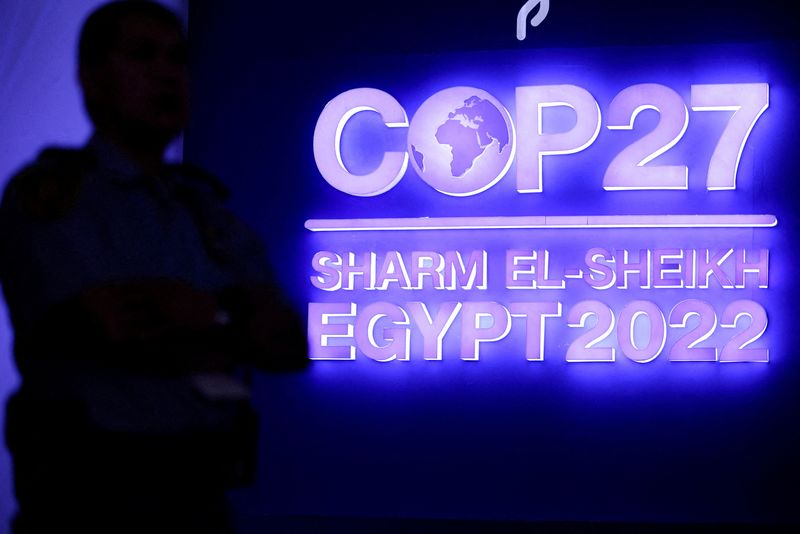By Simon Jessop and Valerie Volcovici
SHARM EL-SHEIKH, Egypt (Reuters) - A deal struck at the COP27 climate talks in Egypt calls for an overhaul of the post-World War Two international financial architecture that has guided three generations of development aid but is struggling to fund the needs of a warmer planet.
As the impacts of climate change worsen, delegates at the U.N. summit that ended at the weekend pressed for reform to speed up the flow of funding to developing countries - to help them cut emissions and cope with the floods or wildfires they are already experiencing.
The final COP27 deal agreed to set up a "loss and damage" fund to help poorer countries pay for the impacts of climate disaster. It also referred to the need to reform international financial institutions.
Avinash Prasad, climate adviser to the prime minister of Barbados, said the agreement reached in the early hours of Sunday had injected momentum into "a much bigger transformation of our global financial system".
It should lead to a tripling of the amount international financial institutions lend "with a clear focus on climate and sustainable development goals," Prasad said.
The push for reforms to help release more finance this year gathered pace when Barbados Prime Minister Mia Mottley helped to draw up suggested steps she then championed at COP27.
Mottley's suggestions include loans at lower interest rates from multilateral lenders such as the World Bank, changes to how ratings agencies assess risks to projects and increased use of International Monetary Fund reserve funds.
She also urged more windall taxes on oil and gas company profits and the pausing of debt repayments for countries hit by climate disasters.
As other leaders lent their backing, U.S. climate envoy John Kerry called for a mosaic of changes to the system to increase the impact of public finance.
Kerry also urged the development banks and their shareholders to come to the banks' meetings early next year armed with plans to free up hundreds of billions of dollars that could release trillions of dollars more of private capital.
Meanwhile, a report by a panel of experts for the G20 group of leading industrialised nations suggested five recommendations for making the development banks better equipped to cope with the demands being made.
BRIDGING A MASSIVE GAP
Many followers of the climate debate see reform of the development banks such as the World Bank Group, in which the U.S. holds the biggest stake, as crucial to closing the gap between the amounts promised and that delivered.
Developed countries have yet to meet a 2009 pledge to provide $100 billion per year in climate finance to developing countries and last year the rich contributed just $83 billion.
The discrepancy versus overall needs is bigger still. A report released during the U.N. talks estimated developing countries will need around $1 trillion a year by 2030 from development banks and private investors.
Last year, the biggest multilateral development banks gave $51 billion in climate finance to low- and middle-income countries, a report from the lenders showed, alongside $13 billion from private investors.
Faced with a torrent of criticism at COP27 from delegates wanting more, the World Bank said in order to increase financing, it needs wealthy donors to provide fresh funds.
Similarly, Akinwumi Adesina, head of the African Development Bank said: "If you want to do more, you actually need more."
"There has to be a lot more increase in capital, for the multilateral development banks," he told Reuters.
Reflecting a wide-spread view at the conference, Australia Climate and Energy minister Chris Bowen told delegates that multilateral development banks, including the World Bank, must adapt in the face of the climate challenge.

"Our international financial architecture is built for a different time and different challenges," he said.
"Some of our financial institutions are stepping up to this task, our most important global job, but others are not."